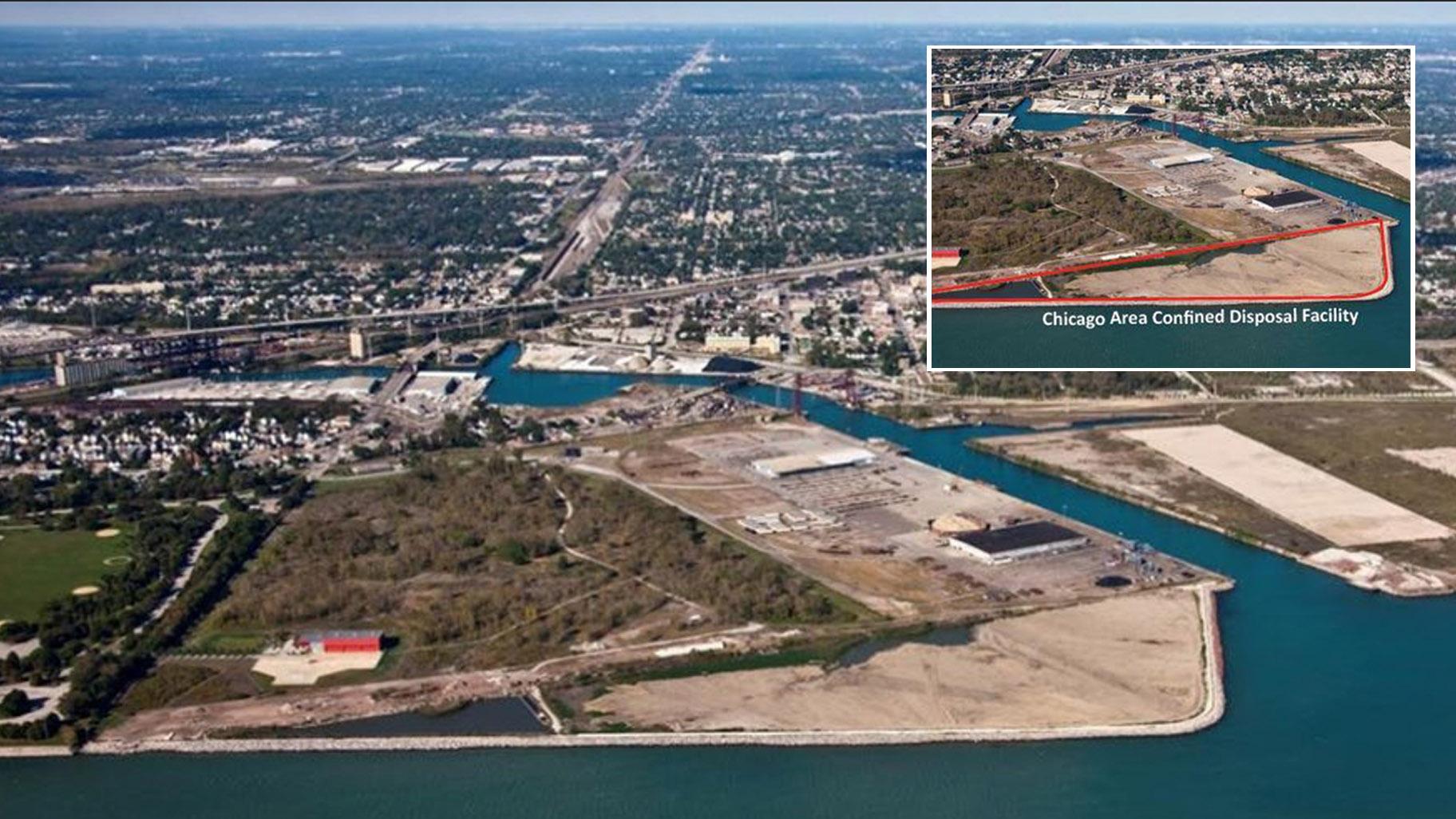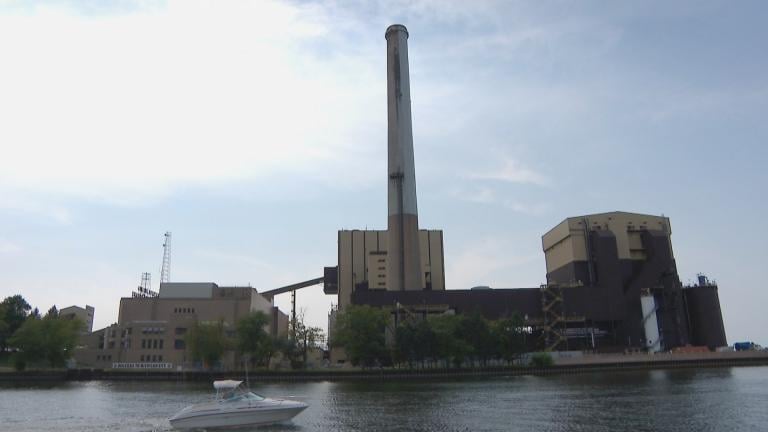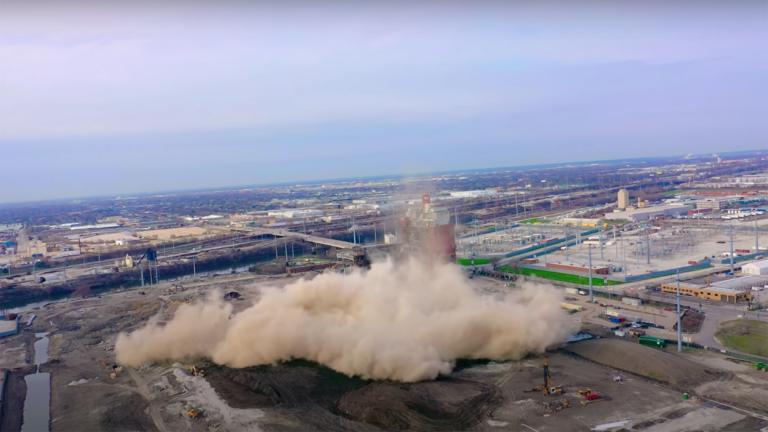 An aerial view of the Chicago Area Confined Disposal Facility, a 45-acre site on Chicago’s Southeast Side that has been in operation since 1984. Inset: The CDF is outlined in red. (Credit: Army Corps of Engineers)
An aerial view of the Chicago Area Confined Disposal Facility, a 45-acre site on Chicago’s Southeast Side that has been in operation since 1984. Inset: The CDF is outlined in red. (Credit: Army Corps of Engineers)
Three years ago, activists said they felt powerless to stop a plan by the Army Corps of Engineers to build a 25-foot-tall toxic sludge dump on Lake Michigan on Chicago’s Far Southeast Side.
Today, the same groups are celebrating the latest bump in the road for the proposal, which has yet to receive long-awaited approval from the Illinois EPA.
The Corps had been set to begin “pre-construction” on the site, a vertical expansion of an existing 45-acre landfill in Calumet Harbor at the mouth of the Calumet River. Since 1984, this is where the Corps has operated a storage facility for the polluted sediment it regularly dredges from the Calumet River and the Cal-Sag Channel.
But the Corps canceled the pre-construction after receiving notice from the Illinois EPA that the work would require a different type of permit than had been granted in the past. The Corps had not anticipated this decision and didn't build the lengthier permit process into its schedule, said Jacob Zdrojewski, chief of public affairs for the Corps' Chicago District.
"Due to the new permit requirement, USACE will be unable to begin construction this summer. Completion of the vertical expansion will be delayed one to two years," he told WTTW News via email.
“We’re definitely excited that the Army Corps’ progress has slowed down,” said Juanita Irizarry, executive director of Friends of the Parks, which is party to a lawsuit against the Corps. “The message has been sent they can’t move forward unchecked. … It’s really significant.”
When the Corps first constructed the landfill — known as a confined disposal facility or dredged material disposal facility — it was initially only authorized by the Illinois legislature for a 10-year period. Eventually, the Corps and General Assembly agreed that, once full, the facility would be topped off and handed over to the Chicago Park District for redevelopment.
As the facility approached its expected capacity, projected for 2022, the Corps decided that instead of mothballing the landfill, it would extend the dump’s life another 20 years via a vertical expansion.
Critics of the expansion plan have said it could lead to compromised drinking water quality, particularly given Lake Michigan’s unpredictable levels and the increasingly strong storms that have eroded waterfront property and sent waves crashing over formerly unassailable barriers. Sludge from the river and channel is loaded with pollutants including arsenic, lead, manganese and mercury.
“Very simply, it defies common sense to put a 25-foot toxic waste tower on the shore of Lake Michigan,” said Howard Learner, president and executive director of the Environmental Law and Policy Center. The center is handling the lawsuit brought against the Corps on behalf of Friends of the Parks and Alliance of the Southeast.
Among the chief legal challenges to the landfill expansion plan is the argument that the Corps didn’t fully comply with the National Environmental Policy Act, which requires agencies to assess the environmental impact of and alternatives to major federal actions.
Learner asserts the Corps didn’t consider alternative landfill sites outside the 10th Ward, home to neighborhoods already overburdened with pollution, in part because NEPA is at odds with a separate law requiring the Corps to pursue the least-cost solution.
“Well, hey, that’s the argument we’ve had on the Southeast Side forever — that it’s close and cheap” for polluting industries, Learner said.
The fact that “‘least cost’ is usually a Black or Brown community” suggests the law needs to be changed, Irizarry added.
Illinois EPA has been reviewing the Corps permit application for the landfill expansion since March 2021. The Corps also submitted a request in March of this year for Clean Water Act Section 401 water quality certification, according to a spokesperson for the Illinois EPA.
A 401 certification is needed in advance of any permit being issued for an activity that “may result in any discharge into waters of the United States,” according to the EPA.
Illinois EPA intends to publish a public notice of the Corps’ application and availability for public hearing prior to final approval, the spokesperson said.
The need to dot all these i’s and cross all these t’s — the applications, the reviews, the public hearings — amounts to delays in the Corps timeline, delays the opposition can use to continue marshaling support against the expansion, Learner said.
“In effect, without the court granting a preliminary injunction, we’ve achieved one,” he said. “This creates room and time for our two senators (Dick Durbin and Tammy Duckworth), for the governor, for the new mayor to come together and say, ‘Let’s look at some alternatives.’ Ultimately, the Army Corps is a public agency. The political leadership should speak to the Corps about finding alternatives.”
Irizarry said she’s cautiously optimistic about the new administration of Mayor Brandon Johnson, who says he is committed to environmental justice and pledged during his campaign to reestablish a Department of the Environment.
With legal actions tying up the project into 2024, there’s time to bring Johnson’s team up to speed, Irizarry said.
“People are still very much learning about the issue,” she said. “Every step is an opportunity to get more people involved.”
This article originally published May 24. It has been updated with new information.
Contact Patty Wetli: @pattywetli | (773) 509-5623 | [email protected]






